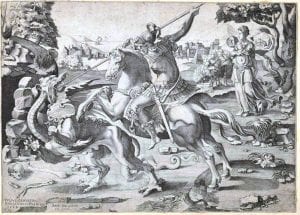Faithful and frightening: The Renaissance imagination explored
A post by Mary Henkel who is an undergraduate student at the University of Melbourne studying Art History.

The intaglio print St. George Killing the Dragon (1542), engraved by Enea Vico (1523-1567) after a drawing by Giulio Clovio (1498 – 1578), was gifted to the Baillieu Library in 1959 by John Orde Poynton who was interested in prints between the time span 1500-1850. Poynton claimed that these would make the University of Melbourne ‘the only university with such a collection yet.'[1.]
Enea Vico was an Italian engraver from Parma who created this print in 1542. It is one of his earliest published works which was created when he was about 19 years old, after his training under Tommaso Barlacchi in Rome. It was published by Antonio Salamanca.[2.]
This print depicts the legend of Saint George, a soldier from Cappadocia near Turkey, who defeats a ferocious dragon with his spear. According to this legend, the citizens of a town near Silene in Libya had been sacrificing their teenage daughters to ward off the tormenting dragon. As the King’s daughter is brought forward, Saint George slays the monster in the name of God and saves her. This act of faith leads 15 thousand townspeople to renounce their pagan superstitions and baptise themselves as Christians. [3.]
It has been argued that this tale may have derived from North Africa, during the 6th century, however it was popular throughout Western Europe from the Middle Ages as Saint George was valorised as a Christian hero. [4.] In Vico’s print, the dragon is depicted as a hideous and frightening monster, Saint George valiantly leans over the dragon with his spear pointed down its mouth as it takes its last ferocious roar. It was a common trope for Saint George to ride a white horse, which was a sign of his saintly purity.[5.] Indeed, it is his intense faith in God which has enabled Saint George to defeat this evil beast. Christian virtue is revealed to triumph over pagan beliefs.
There was a strong interest in ancient Greek and Roman culture throughout Italy during the 16th century. Humanist scholars sought to revive and surpass the achievements of their ancient predecessors and looked to classical art as the standard of cultural excellence. [6.]
Beyond his technical accomplishments as a printmaker, Enea Vico was esteemed for his scholarship of Roman coins. Giorgio Vasari, who was a friend of Vico, wrote that he desired ‘devoting himself to greater and more important undertakings [than printmaking] … his attention to the study of antiques, more particularly to that of ancient medals’ which lead Vasari to regard Vico as ‘possessing much elevation of genius.’ [7.] Vico’s interest in ancient Roman coins and medals is seen in the image where the profile of the princess’s face resembles the portrait Vico published in 1558, of the Roman Empress Flavia Julia Constantia, after an ancient coin.
It is interesting that Enea Vico has dressed Saint George in ancient Roman armour. In early Rome the thorax armour, which covers Saint George’s torso, was a sign of prestige and was worn only by those in the highest ranks and later by centurions. [8.] Like an ancient military hero, Saint George is portrayed as an elite soldier and represents a classical archetype of masculinity; his face is focused and rational while his body is muscular and well proportioned.
In contrast to Saint George, the dragon has been depicted in a grotesque style. The term ‘grotesque’ comes from the discovery of frescos found in the grotte – underground rooms – of the palace of the Roman Emperor Nero. The preserved paintings display sinuous designs that blend naturalistic elements in strange and fantastical combinations.[9.] Vico’s dragon is a hybrid of animal features, it has bat wings, a serpent neck and eagle claws. This monster deviates from classical ideals of natural order and perfection; it is hideous and it’s strange and irregular appearance make it a frightening creature. Dragons were often employed as symbols of evil in religious art and designed to provoke fear in viewers.[10.] Saint George’s slaughter of the dragon heroizes Christian faith and the restoration of virtue.
This print remains an astonishing work from Cinquecento Italy and indeed Poynton’s gift remains an extraordinary contribution to the Baillieu Library Print Collection.
References
[1.] Poynton, letter to Lodewycks, 12 August 1960, see Kathleen Kiernan ‘Lonely traveller in a transient world‘,in University of Melbourne Collections, Issue 2, July 2008, pp. 14-20.
[2.] David Landau and Peter W. Parshall, The Renaissance Print, 1470-1550, Yale University Press, 1994, p. 308.
[3.] Saint George and the Dragon.
[4.] George M. Eberhart, Mysterious Creatures: A Guide to Cryptozoology, Santa Barbara: ABC-CLIO, 2002, p. 145. James Hall, “George.” in Dictionary of Subjects & Symbols in Art, Revised edition, Colorado: Westview Press, 1974, pp. 136-137.
[5.] Landau, The Renaissance Print, 1994, p. 99.
[6.] Department of European Paintings. ‘The Rediscovery of Classical Antiquity.’ Heilbrunn Timeline of Art History, New York: The Metropolitan Museum of Art, October 2002.
[7.] Giorgio Vasari, Lives of the Most Eminent Painters, Sculptors, and Architects, Volume 3, trans. Mrs. J. Foster, London: J. Haddon Printers, 1885, p. 513.
[8.] Carolyn Springer, Armour and Masculinity in the Italian Renaissance, Toronto: University of Toronto Press, 2010, p. 25. Janet S. Bryne, Renaissance Ornament Prints and Drawings. New York: Metropolitan Museum of Art, 1981, pp. 60-62.
[9.] Janet S. Bryne, Renaissance Ornament Prints and Drawings. New York: Metropolitan Museum of Art, 1981, pp. 60-62.
[10.] Ariane and Christian Delacampagne, Here Be Dragons: A Fantastic Bestiary, Princeton: Princeton University Press, 2003, p. 27.
Leave a Reply